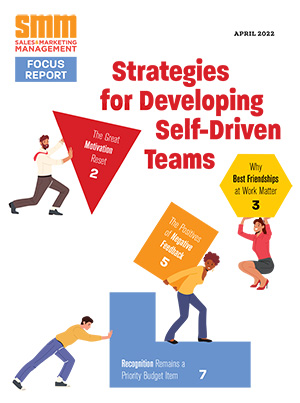Steven Huber, president of a Southern California-based in-home care provider, rewards top performers at his company — both in sales and non-sales positions — with multi- day resort experiences.
“When properly executed, incentive travel programs and offsite meetings are a great way to increase employee engagement and retention,” said Huber, president of Home Care Providers.
Lindsay Grosz, president of Lindsay Grosz Events, said a client of hers in real estate development regularly brings key business partners together at two- and three-day events.
“It’s a way for him to ingratiate himself with all the different parties involved in real estate development,” Grosz said. “With the understanding that a lot of business occurs at the resort bar, these events are also a way for participants to drum up business for themselves.”
It’s Not Just for Sales Reps Anymore
Bringing top performers and business partners together to celebrate successes and cement relationships has been done for as long as there have been resorts to convene at. Incentive travel professionals say these programs continue to primarily be targeted to sales personnel, in part because the qualification metrics can be straightforward and the ROI is easier to measure.
However, increased awareness of the importance of employee retention across all roles (including the high cost of onboarding new employees) has resulted in some expansion of incentive travel program design to include non-sales employees. The Incentive Travel Index, an annual report produced by the Incentive Research Federation (IRF) and the Society for Incentive Travel Excellence (SITE) reports “senior leadership want incentive travel to do more, meaning that both soft-power and hard-power themes are being emphasized.”
More than 2,800 incentive industry professionals plus corporate end users were surveyed for the 2024 Incentive Travel Index.
Richelle Suver, chief revenue officer of One10, a provider of incentive and recognition programs, said the large corporate incentive users that her company serves continue to use incentive travel primarily for sales programs and recognize non-sales workers with a points platform that One10 provides. Points can be accumulated and exchanged for merchandise, event tickets, travel and other rewards.
Better ROI Measurement
Incentive travel remains the most expensive form of non-cash recognition a company can implement. The IRF estimates U.S. businesses spend $22.5 billion annually on incentive travel programs.
The Incentive Travel Index puts average spend per program participant at $4,900. More than one-quarter of respondents to the Index survey reported spending between $3,000 and $5,000 per participant. The trend with these programs is increased spending. Companies feeling pressure to truly wow their reward recipients have spent $25,000 or more per participant. Boutique hotels, extravagant soirees, live performances by well- known musicians and once-in-a-lifetime experiences such as Canne Film Festival yacht parties are characteristic of top line corporate events.
“Typically, the people who win these trips are fairly accomplished and high net worth individuals who can purchase nice trips for themselves. If an incentive trip is not unique and special, it’s just a vacation,” said Suver. Companies like One10, she added, can create elements of a travel experience that individuals can’t replicate on their own.
Of course, if that sort of money is being spent on rewards, corporate executives are meticulous about verifying a return on their investment. Or are they?
Alexis Berlin, co-founder and chief growth officer of Awestruck Incentives, says too many users of corporate incentive travel are shockingly lax about measuring the ROI of their programs. A Harvard graduate and former business analyst at McKinsey, Berlin said when she was on the other side of conversations about business travel spend, the focus was entirely on cost conservation.
“It was always, ‘Are we within budget?’ ‘Can we reduce the budget and get the same results?’ ‘If we’re struggling, where can we cut event travel?’ It was never discussed as a lever for growth.”
A press release from Awestruck Incentives, posted when the company launched earlier this year, states that Awestruck is introducing proprietary planning and measurement services that “blend elite strategy consulting experience with award- winning travel execution to transform corporate retreat and incentive event travel into a strategic, measurable growth asset.”
“Travel has become transactional at the very moment at which it needs to be transformational,” Berlin states in the press release. “During my time at McKinsey, I saw this firsthand. In billion-dollar transformations, travel was only ever mentioned as a line item to cut. We need a full paradigm shift: from event travel as a cost center to event travel as a growth lever.”
Her opinion that incentive travel programs have largely been carried out with little or no proof the programs themselves have led to increased sales will likely ruffle longtime developers of these programs as well as corporate users of incentive travel (not to mention research organizations like SITE and the IRF). Nonetheless, Berlin says she was aghast when she read an article recently in which leading event travel companies claimed the strategic outcomes of event travel cannot be measured.
“There is no other area of business where a good strategic partner would go to them and say, ‘Spend $1 million, but I can’t tell you how that’s moving the needle on your strategic goals.’ Nobody is bringing the kind of rigor to it that helps substantiate the claim to CFOs in a challenging macroeconomic environment that these trips do drive sales, they do drive retention, and they do reduce turnover,” Berlin said.
A More Mindful Approach
Berlin said too many companies run the same incentive travel campaign year after year with minor tweaks based on participant feedback. The focus is on getting the participants to the destination affordably and getting the most bang for the buck while on site.
“We don’t come in and help you set enterprise strategy. Your business is your business. What we will help do, with our decades of expertise, is help you understand which of your goals is actually well-serviced by event travel,” she said.
She provided the hypothetical of a company that has grown through acquisitions and has increased the number of middle managers it employs. Such a company may continue to run a classic President’s Club incentive program for top sellers, yet may be struggling with middle managers who feel disconnected from executives and passed over for promotions.
In such a case, Berlin said, a more strategic spend of at least a portion of the company’s event travel dollars may be a retreat for 50 to 60 middle managers in which they spend quality time with executives, are sounded out for ideas, and reassured their roles are critical to the company’s success.
“We don’t think we can be a good travel partner unless we have the same understanding — the same laser focus — on your strategic goals that every single one of your executives has,” she said.
Beyond Boosting Sales
As Suver and others stated, incentive travel programs continue to predominantly focus on motivating salespeople to hit — or preferably exceed — quotas. However, according to the Incentive Travel Index, the strategic importance of incentive travel is being bolstered by other key workplace objectives, including retaining employees and gaining competitive advantages in hiring.
55% of senior managers surveyed feel incentive travel is an essential component of their compensation strategy, according to the Index report. Interestingly, 41% of senior managers agree that many rewards today are perceived as “deserved,” and thus they lack the motivation and culture building power that incentive travel still delivers.
Michael Benoit, founder of California Contractor Bond & Insurance Services, told SMM his company sponsors incentive travel programs for both sales and non-sales employees. He recently treated 18 underwriters and their companions to a three-day trip to Lake Tahoe, where they hiked together, enjoyed a lake cruise and held structured sessions in the evenings that included an awards ceremony and professional development workshops.
“In our industry, incentive travel has been more effective when not restricted to sales teams. Underwriters and administrative staff often go unrecognized, but their performance affects client satisfaction directly,” Benoit said.
As for ROI, Benoit credits the trip in large part for a 22% reduction in turnover the following year, saving more than
$7,500 per avoided replacement hire. “That type of measurable return makes the expense [$25,000] defendable to leadership,” he said. “In addition to the reduced turnover, we tracked a 15% improvement in response time to clients, and a decrease in processing errors in the few months afterward. Both of these measures tie back to increased customer satisfaction”
Structure Minus the Rigidity
Planning an effective incentive travel experience requires a combination of intentionality of purpose and flexibility, said Katy Moser Stuck, director of marketing and business development at GoGather, which helps companies create group travel events and offsite meetings.
Stuck said building C-suite interaction into an incentive travel experience is a key component of almost every event they plan. Attendees see real value in having concentrated time with a company’s leaders. It’s a good idea to coach those leaders ahead of time on what participants want out of those encoun- ters. Top revenue producers want to feel heard and want to feel appreciated, Stuck said.
The best incentive travel events find a delicate balance between team celebrations and enough breathing room to allow participants to enjoy time on activities of their choosing.
“When your entire team has a history of going through something, they come back with a unified story that strengthens a sense of belonging,” Anthony Bowers, founder of LMI Waiver, an Australian company that helps clients secure home loans, told SMM in responding to a query to incentive travel users.
“That memory is usually used as a point of reference when making difficult projects and choices. That feeling of correspondence and trust is the true payback on the investment.”





